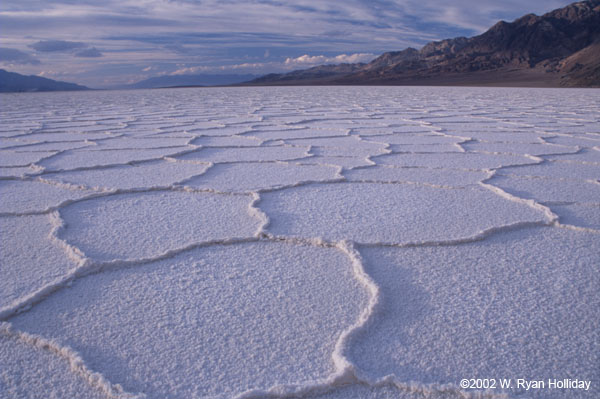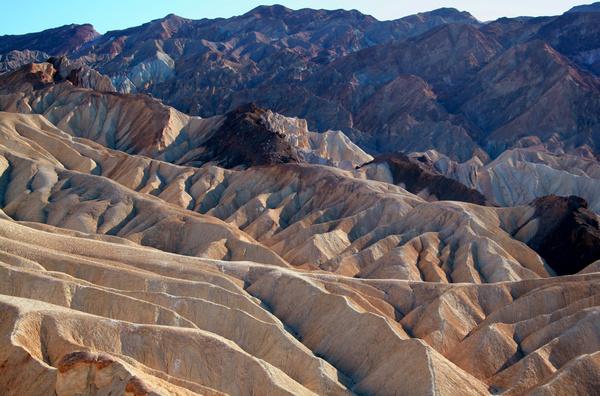 Wadi: An arabic term that refers to a valley. In some cases it can also refer to a dry riverbed that only experiences water when there is a heavy rain fall. Unlike other valleys a wadi has been cut and eroded by water however because it is in desert it rarely experiences any constant water except for during the rainy season. Deposition is very common in a feature such as this because of the fact that the water dries up and is no longer able to carry a load of sediment that it has.
Wadi: An arabic term that refers to a valley. In some cases it can also refer to a dry riverbed that only experiences water when there is a heavy rain fall. Unlike other valleys a wadi has been cut and eroded by water however because it is in desert it rarely experiences any constant water except for during the rainy season. Deposition is very common in a feature such as this because of the fact that the water dries up and is no longer able to carry a load of sediment that it has.  Playas: An area of very dry land that is found below the sea level. Flats like this often consist of fine grained sediments such as salts. During the dry season the surface of the lake is usually hard and rough, where as in the rainy season it gets wet and soft. The water usually creates a small hole meaning there is a very shallow lake in the desert.
Playas: An area of very dry land that is found below the sea level. Flats like this often consist of fine grained sediments such as salts. During the dry season the surface of the lake is usually hard and rough, where as in the rainy season it gets wet and soft. The water usually creates a small hole meaning there is a very shallow lake in the desert.  Alluvial Fans: Often found in the desert where periodic flash floods occur. They often have a large funnel shaped basin at the top which then creates a very narrow stream which then opens into an alluvial fan at the end of its course. These alluvial fans are often home to much more life and plants then the rest of the desert due to the fact that any nutritional sediment and water will end up here.
Alluvial Fans: Often found in the desert where periodic flash floods occur. They often have a large funnel shaped basin at the top which then creates a very narrow stream which then opens into an alluvial fan at the end of its course. These alluvial fans are often home to much more life and plants then the rest of the desert due to the fact that any nutritional sediment and water will end up here. 
Bajada: When many alluvial fans all come together in one place, or deposit in the same area it creates a bajada. Because of the gathering of all the fans it means that there is much more water and sediment then usual, and it is quite evenly spread out throughout the whole bajada.
 Mesa: An elevated area of land that has a very steep sides and a flat top. They are formed by the weathering and erosion of horizontally layered rocks that are lifted by the tectonic activity of the area. Due to the fact that some rocks erode faster then others, or others are stronger it means that stronger rocks usually make it to the top and the weaker rock is at the bottom.
Mesa: An elevated area of land that has a very steep sides and a flat top. They are formed by the weathering and erosion of horizontally layered rocks that are lifted by the tectonic activity of the area. Due to the fact that some rocks erode faster then others, or others are stronger it means that stronger rocks usually make it to the top and the weaker rock is at the bottom.  Canyon: A deep ravine between cliffs, often carved into the landscape by a river. They are formed when there is stronger rock on either side of where the water is eroding. This means that the water is able to cut vertically but not horizontally.
Canyon: A deep ravine between cliffs, often carved into the landscape by a river. They are formed when there is stronger rock on either side of where the water is eroding. This means that the water is able to cut vertically but not horizontally. Deflation Hollow or Basin: Created by wind action. Fine grained particles from rocks that are easily weathered are carried away creating a hollow. As the hollow deepens they collect water during the rainy season. This water helps speed up the weathering of the rock creating more particles to be blown away by the wind. Due to this the hollow is able to deepen faster then the rest of the land surrounding it, creating a large hole in the ground.
Deflation Hollow or Basin: Created by wind action. Fine grained particles from rocks that are easily weathered are carried away creating a hollow. As the hollow deepens they collect water during the rainy season. This water helps speed up the weathering of the rock creating more particles to be blown away by the wind. Due to this the hollow is able to deepen faster then the rest of the land surrounding it, creating a large hole in the ground. Barchan: A sand ridge in the shape of an arc. Wind can often push the dunes through the desert, and they can stretch in size anywhere from a few meters to hundreds of meters long. They occur in the opposite direction of the parabolic dunes and have their steep slip face on the concave instead of the convex of the dune. Its extend arms are in front of it instead of behind it.
Barchan: A sand ridge in the shape of an arc. Wind can often push the dunes through the desert, and they can stretch in size anywhere from a few meters to hundreds of meters long. They occur in the opposite direction of the parabolic dunes and have their steep slip face on the concave instead of the convex of the dune. Its extend arms are in front of it instead of behind it. Parabolic Dunes: U or V-shaped mounds of sand that has an elongated arm that extends upwind. They are always associated with vegetation which help anchor the trailing arms of the dune. They are found in areas where the wind only blows in one directions. Slip faces occur on the outer size of the dune and on the slops of the elongated arms.
Parabolic Dunes: U or V-shaped mounds of sand that has an elongated arm that extends upwind. They are always associated with vegetation which help anchor the trailing arms of the dune. They are found in areas where the wind only blows in one directions. Slip faces occur on the outer size of the dune and on the slops of the elongated arms.
Pedestal Rock: A large bolder on top of a very narrow base. This occurs when there is soft rock underneath that is easily eroded and harder rock on top that can not be eroded away.
 Arch: Formed where there is soft rock surrounded by hard rock. Deep cracks penetrate into the sandstone layer and erosion wears away exposing the rocks layers and enlarging the surface cracks. Softer rock gets broken away by wind and the little amount of rain forming arches where the soft rock being broken away creates a hole in the harder rock.
Arch: Formed where there is soft rock surrounded by hard rock. Deep cracks penetrate into the sandstone layer and erosion wears away exposing the rocks layers and enlarging the surface cracks. Softer rock gets broken away by wind and the little amount of rain forming arches where the soft rock being broken away creates a hole in the harder rock. Salt Flats: Formed where there are dry lake beds. It is an area of very dry land that occurs below the sea level. It receives much of the sediment that is deposited. In the case of a salt flat this if often salt deposits that are left in a large dry lake bed.
Salt Flats: Formed where there are dry lake beds. It is an area of very dry land that occurs below the sea level. It receives much of the sediment that is deposited. In the case of a salt flat this if often salt deposits that are left in a large dry lake bed. Badland: Form where deep beds of easily eroded rock is exposed to erosion. The infrequent heavy rains are able to cut out stream channels. This results in gullies, carved hillsides and tall spires of the most resistant rock to erosion.
Badland: Form where deep beds of easily eroded rock is exposed to erosion. The infrequent heavy rains are able to cut out stream channels. This results in gullies, carved hillsides and tall spires of the most resistant rock to erosion.Despite the lack or limited amount of precipitation in deserts, water is the major agent of erosion. Rainfall when it comes is brief and intense, and due to the hard rocky surface and limited vegetation tends to RUN OFF, creating FLASH floods. Because of limited precipitation PHYSICAL weathering is dominant. The main physical processes are HEATING-COOLING ,FREEZING-THAWING, and EXFOLIATION. Despite the fact that water is the most important agent of erosion in deserts, wind is quite important too. The action of wind eroding, transporting and depositing sediments is called EOLIAN processes. Wind erosion is common because there is little VEGETATION to hold the sand or sediment in place. Deflation is the large scale removal of sediment by wind. Abrasion is the process where sand carried by the wind “sandblasts” rocks. Regions covered in sand are called SAND SEAS or ERGS. Regions which are bare rock are called DESERT PAVEMENTS or REGS in Algeria.

Thank you! Really helped me on an assignment! :)
ReplyDeletei like chicken
ReplyDeleteThank you very much! I was confused by this Chapter but thanks to you, I think I get it!.
ReplyDeleteAs I am about to go trekking in the Sahara in Morocco this was a great help. Thank goodness for people like you who take the time to share their knowledge. Thank you
ReplyDeleteAs I am about to go trekking in the Sahara in Morocco this was a great help. Thank goodness for people like you who take the time to share their knowledge. Thank you
ReplyDeleteU helped me my brother thank u very much keep it up God bless u Amen
ReplyDeletethank you it helped me so much to study for an important exam
ReplyDeleteThanks it helped me much on my assignment
ReplyDeleteThanks was so helpful
ReplyDeletethis information was helpful to me
ReplyDeletea big thank you.
ReplyDelete